Fiber Optics Solutions
utorak, 05.05.2015.
FAQs of SFP modules
Can I use SFP+ optics in SFP ports or use SFP optics in SFP+ ports?
Not all, it's depending on whether the SFP ports accept SFP+ optics (SFP+ 10GBASE Twinax cables and SFP+ modules) or not. However, most (not all) SFP+ ports accept SFP optics. Most 1Gb and 10Gb SFP+ optics only support a single speed (e.g. 10Gb optics can't run at 1Gb). As long as you have a 1Gb SFP at both ends you shouldn't have a problem.
The Summarize of SFP Module
The structure of SFP optical module are: laser, including transmitter and receiver, external fittings are: base, shell, PCBA, unlock pieces, TAB, card buckle, rubber plug, the other to help you identify the convenient, general using the color of the TAB to recognize the parameters of the module type.
According to the rate divided 155M/622M/1.25G/2.125G/4.25G/8G/10G, 155M and 1.25G currently available on the market use more, 10G technologies are maturing, demand positive attitude to rise development is the next major optical module products.
According to the wavelength divided 850nm/1310nm/1550nm/1490nm/1530nm/1610nm, as SFP 850nm wavelength multimode transmission distance 2km less frequent like Cisco GLC-SX-MM; 1310/1550nm wavelength for Single-mode, the transmission distance 2KM above, relatively speaking, these 3 wavelengths lower cost compared to the other.
If you can't know the bare module is simple to confuse the normal distinction between manufacturers will pull rings in color, take CWDM SFP module as an example: black pull ring for multimode wavelength is 850nm; blue wavelength 1310nm module; yellow is the wavelength of 1550nm module; purple is the wavelength of 1490nm module.
Why choose compatible SFP Module
The simple answer to this query (as most other suppliers will explain) is cost, but that's just one of the reasons to purchase a compatible SFP, SFP+ or XFP fiber optic transceiver. For example in a scenario where gigabit speed is required to run across a point-to-point link, the distance between the link length is assessed and an appropriate SFP transceiver module native to the host device is chosen. If a Cisco platform was in situ then the selection of module will be limited by among the following: 550meter (GLC-SX-MMD), 10km (GLC-LH-SMD), 40km (GLC-EX-SMD) or the maximum 70km (GLC-ZX-SMD). Using a compatible SFP you can choose from a variety of distance limits from 550meters up to 100km in numerous increments with distances of 160km being achievable on the top product lines.
Another advantage of use compatible SFP transceivers is the freedom to tailor the transceiver to your individual requirement.
- Custom serial numbers can be added both to the product label and also hard coded to the device itself.
- Customer Logos can be added to the products.
Latches can be color coded for high density link identification Fiberstore also provide a recoding service in China, this specific service means existing SFP's can be adapted if the host device is to be changed. In some instances, even cross-device compatibility is quite possible.
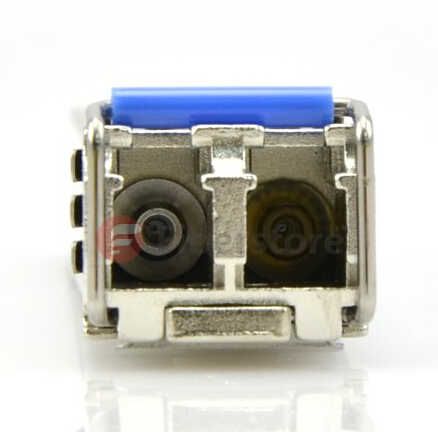
SFP transceiver is a very popular format that’s recommended by a large number of fiber optic component providers. These businesses carry SFP transceivers for those Cisco and HP devices along with transceiver modules for many other manufacturers. Especially, you can find a full product line of our New HP SFP modules, such as J4858C, J4859C, JD118B, and JD092B, etc. Our HP SFP and SFP+ moduels are 100% compatible with a good price and enjoy same-day shipping.
Oznake: SFP module, SFP Transceiver, HP J4859C, Cisco SFP
ponedjeljak, 20.04.2015.
D-Link 1000BASE SFP Module Introduction
D-Link Introduction
As the leading brands of networking equipment maker, D-link devoted itself to develop, manufacture and sale Local Area Network (LAN), broadband network, wireless network and voice network products for the digital home, Small Office/Home Office (SOHO), Small to Medium Business (SMB) and Work-group in the worldwide. Energy conservation and environmental protection are always the primary goal for D-link. There are many fiber products from D-link. Today, I will introduce an essential part of the switches product line—the D-Link SFP transceiver modules.
About D-Link's SFP Modules
D-Link's new line of GBIC and SFP transceivers represent an industry leading combination of performance and affordability. D-Link's new Gigabit transceivers are available in two form-factors: standard (GBIC) or (SFP) /mini-GBIC. SFP modules can be used and interchanged on a wide variety of switches and routers. And SFP modules also can be intermixed in combinations of 1000BASE-T, 1000BASE-SX, 1000BASE-LX/LH, 1000BASE-EX, 1000BASE-ZX, or 1000BASE-BX10-D/U on a port-by-port basis.
D-Link 1000BASE-T SFP
The D-Link DGS-712 1000BASE-T is based on the SFP Multi Source Agreement (MSA). It is compatible with the Gigabit Ethernet and 1000BASE-T standards as specified in IEEE 802.3z and 802.3ab. The DGS-712 plugs into any standard SFP interface and allows for 1000Base-T Gigabit transmission over standard Category 5 twisted pair copper.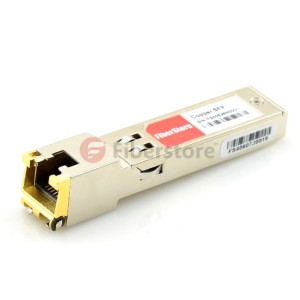
Key Features
- Product Type: SFP transceiver module
- Data Rate: 1Gbps
- Wavelength: N/A
- Transfer Distance: 100m
- Connector Type: RJ45
- Cable Type: Copper
D-Link 1000BASE-SX SFP
D-Link DEM-311GT 1000BASE-SX SFP 850nm transceiver module supporting dual data-rate of 1.25Gbps/1.0625Gbps and 550km transmission distance with Multi-mode Fiber (MMF). It was designed to meet Gigabit Ethernet and 1 times Fibre Channel application networking. It fully comply with the SFP Multi-Sourcing Agreement to meet the network upgrade needs.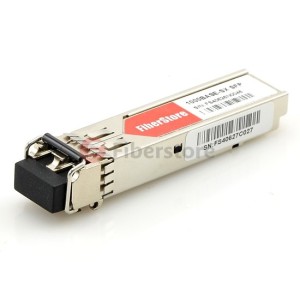
Key Features
- Product Type: SFP transceiver module
- Data Rate: 1Gbps
- Wavelength: 850nm
- Transfer Distance: 550m
- Connector Type: LC Duplex
- Cable Type: Multi-Mode Fiber (MMF)
D-Link 1000BASE-LX SFP
D-Link DEM-310GT is the 1000BASE-LX LC SFP 1310nm transceiver module. It supports dual data-rate of 1.25Gbps/1.0625Gbps and 10km transmission distance with Single-mode Fiber (SMF). With a metal housing, it can effectively reduce Electro-Magnetic Interference (EMI) and increase durability.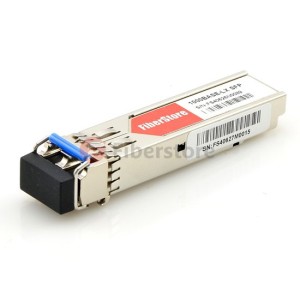
Key Features
- Product Type: SFP transceiver module
- Data Rate: 1Gbps
- Wavelength: 1310nm
- Transfer Distance: 10km
- Connector Type: LC Duplex
- Cable Type: Single-Mode Fiber (SMF)
D-Link’s SFP Module Alternative Solution
Fiberstore offers third party optical transceivers. All the D-Link SFP transceiver is certified 100% compatible with D-Link switch and router product lines. Fiberstore provides D-Link DGS-712, D-Link DEM-311GT, DEM-310GT Compatible D-Link 1000BASE SFP interface. All the SFP transceiver modules are 100% tested before shipping and have a lifetime warranty.
Article Source: D-Link’s SFP Module Alternative Solution
Oznake: Cisco SFP, GLC-T, GLC-LH-SM, GLC-ZX-SM
subota, 28.02.2015.
Fake SFP and the Third Party SFP
It appears to be an old topic that whether using compatible SFP transceiver is reliable. We have previously discussed this topic couple of days ago. For certain, the reply is affirmative. In this paper we discuss Faked SFP and the Third Party SFP. As examples, there are Cisco SFP module and Brocade SFP module.

It Is A Faked SFP?
Like a break pad an SFP is somewhat a consumable. Light is converted into an electric signal and vice versa, produces heat and the components wear out over time. Some sooner, some later. When you bought the SFPs from Cisco for a switch under Cisco warranty or maintenance, broken SFPs will be substituted for free. However, if you simply decide to purchase an SFP, you will find after having a quick web search that there are lots of supplier out there providing the same SFP for a much cheaper price than Cisco. And with "the same SFP" I mean they provide exactly the same Cisco part number - for example Cisco GLC-SX-MM. That's an 1000BASE-SX SFP 850nm 550m transceiver.
Really The Same SFP?
Absolutely not - even though they claim it to be the same. Their usual explanation is, that all these SFPs are coming from the same manufacturer anyway. SFPs are built using open standards based on T11 and for that reason they must be compatible per se. I can tell from several occasions: That's not true. There is obviously more than one SFP manufacturer and I'm sure each of you know a handful offhand. In addition: Even in times before 8G there were SFPs working much better with certain switches than others.
Utilizing the 8G platform Brocade decided to offer Brocade branded SFPs and restricted their switches to only support them and to refuse others (beside of very few exceptions for CWDM SFPs). So Brocade took control over which SFPs can be used and they were able to fine tune their ASICs to allow better signal handling and transmission. To enforce that the switch checks the vendor information from the SFP to determine if it's a Brocade branded one. Cisco does the same thing for the SFPs in their switches.
Faked SFP vs Third Party SFP
First, we must realize that Third Party SFP isn't faked SFP. If you are seeking further savings on your own network, consider Third Party SFP. When you purchase from a vendor with their own in-house shop, and guaranteed warranty, you get a purchase that's as reliable as new, at a fraction of the original costs. In my opinion, if you have enough budget, It is best to buy the original one. It doesn’t mean that the compatible one is as not good as the original one but you could save more time in thinking about this question. If you care about the cost, compatible one is the best choice, I suggest you choose the OEM manufacturers.
OEM manufacturers Recommendation
Fiberstore is a OEM manufacturer that provide customized solutions for fiber optics needs, As a Cisco OEM SFP transceiver provider, they offer a series of Cisco comaptible SFP modules which can be equivalent to Cisco GLC-T, Cisco GLC-SX-MM, Cisco GLC-LH-SM, Cisco GLC-ZX-SM, and Cisco CWDM SFP, Cisco DWDM SFP, etc. All their SFP transceivers are 100% compatible with major brands as follows and backed by a lifetime warranty.
Oznake: Third Party SFP, Faked SFP, Cisco SFP, GLC-T
četvrtak, 26.02.2015.
Fiber Optic Transceivers Today and Tomorrow
Fiber optic transceivers is a self-contained component that can both transmit and receive. Usually, it is inserted in devices such as routers or network interface cards which provide one or more transceiver module slot, such as GBIC module, SFP transceiver, XFP, etc.
Fiber Optic Transceivers Today
Fiber optic transceivers for applications in the field of datacom are mostly characterized by a couple of established international standards. These standards define the electro-optical performance of a transceiver/transponder as well as its pinout and its physical outline and package, including the corresponding fiber optic connector interfaces.
Fiber optic transceivers meeting these standard are operating worldwide in numerous applications in mainframes, server clusters, storage area networks, wide area networks, and local area networks, and currently around 20 to 30 worldwide competing suppliers have been established. The number of partners involved in some important multisourcing agreements has seen an increase since 1989. This is also indicative of the increasing importance of industrial associations where both suppliers and applicators are represented. This speeds up the market penetration of novel components, systems, and applications. Nowadays, this does not seem to generate conflicts with the commonly agreed normative power of international standardization organizations such as the Internationnal Organization for Standardization (ISO), International Electrotechnical Commission (IEC), and International Telecommunication Union (ITU).
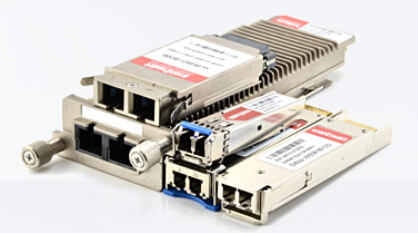
The demand for these transceivers has continuously increased during the past 10 years, and the prices have shown dramatic decreases of order of 25% per year. Consequently, the goal of all manufacturers is to offer a high level of performance, reliability, quality, and serviceability while maintaining cost-effective production in the face of drastically increased volumes to meet the market pricing.
Some Aspects of Tomorrow's Transceivers
The bit rates of fiber optic transceivers are continuously increasing in order to meet the worldwide demand for ever higher bandwidths. These bandwidth increases are called for by both existing storage and networking markets, as well as the parallel computing industry and high end server design.
In the past 10 years, a significant reduction of transceiver module size was possible due to significant progress in the downsizing of optical subassemblies and associated passive and active electronic comparison of the ESCON/SBCON outline, multistandard, small form factor (SFF), and parallel SNAP-12 transceivers. The function of the transceivers shown is described in detail in my previous blog posts.
Future transceiver design is likely to focus on power consumption, electromagnetic compatibility and immunity, and density. As data rates continue to increase, we will start to see transceivers used closer to the ICs on the board and not just at the card edge. It has also been demonstrated the is possible to incorporate optical components onto a chip, completely avoiding the deficiencies of high-speed signals on copper board traces. While these advancements may take their place in high-end computing systems, classical card edge transceivers are likely to continue to play their role into the foreseeable future to allow fiber cable connection for SANs and networking.
Where to Buy Fiber Optic Transceivers
Fiber optic transceiver is a very popular format that's recommended by a large number of fiber optic component providers. Fiberstore provide a full range of optical transceivers. Cisco, especially, you can find a full product line of our New Cisco SFP modules, such as GLC-T SFP, SFP-GE-T, GLC-SX-MM, etc. Our SFP and SFP+ moduels are 100% compatible with a good price and enjoy same-day shipping.
Oznake: Fiber Optic Transceivers, SFP, Cisco SFP
srijeda, 11.02.2015.
How to Install or Remove QSFP Transceiver Module
QSFP/QSFP+ Installing Steps
Step 1: Attach an ESD wrist strap to yourself and a properly grounded point on the chassis or the rack.
Step 2: Remove the QSFP+ transceiver module from its protective packaging.
Step 3: Check the label on the QSFP+ transceiver module body to verify that you have the correct model for your network.
Step 4: For optical QSFP+ transceivers, remove the optical bore dust plug and set it aside.
Step 5: For transceivers equipped with a bail-clasp latch:
a. Keep the bail-clasp aligned in a vertical position.
b. Align the QSFP+ transceiver in front of the module's transceiver socket opening and carefully slide the QSFP+ transceiver into the socket until the transceiver makes contact with the socket electrical connector.
Step 6: For QSFP+ transceivers equipped with a pull-tab:
a. Hold the transceiver so that the identifier label is on the top.
b. Align the QSFP+ transceiver in front of the module's transceiver socket opening and carefully slide the QSFP+ transceiver into the socket until the transceiver makes contact with the socket electrical connector.
Step 7: Press firmly on the front of the QSFP+ transceiver with your thumb to fully seat the transceiver in the module's transceiver socket.
Please Note: If the latch is not fully engaged, you might accidentally disconnect the QSFP+ transceiver module.
Step 8: For optical QSFP+ modules, reinstall the dust plug into the QSFP+ transceivers optical bore until you are ready to attach the network interface cable. Please Note: Do not remove the dust plug until you are ready to attach the network interface cable.
QSFP/QSFP+ Removing Steps
Step 1: For optical QSFP+ transceivers, disconnect the network interface cable from the QSFP+ transceiver connector.
Step 2: For QSFP+ transceivers equipped with a bail-clasp latch.
a. Pivot the bail-clasp down to the horizontal position.
b. Immediately install the dust plug into the transceivers optical bore.
c. Grasp the sides of the QSFP+ transceiver and slide it out of the module socket.
Step 3: For QSFP+ transceivers equipped with a pull tab latch
a. Immediately install the dust plug into the transceiver's optical bore.
b. Grasp the tab and gently pull to release the transceiver from the socket.
c. Slide the transceiver out of the socket.
Step 4: Place the QSFP+ transceiver into an antistatic bag.
Note: In fact, the installing or removing steps of the mentioned transceiver modules are the general case. Different transceiver modules of different brands have their own features. We should ask the vendor to get more informations when you face a problem that we do not mentioned here. In addition, to save more money, we suggest that compatible 3rd transceiver modules may be another good choice but you should ensure that your vendor is reliable.
Fiberstore's fiber optic transceivers are 100% compatible with major brands like Cisco, HP, Juniper, Nortel, Force10, D-link, 3Com. They are backed by a lifetime warranty so that you can buy with confidence. Additionally, customize optical transceivers to fit your specific requirements are available.
Cisco, especially, you can find a full product line of our New Cisco SFP modules, such as GLC-LX-SM-RGD, SFP-GE-T, GLC-SX-MMD, etc. Our SFP+ and QSFP+ moduels are 100% compatible with a good price and enjoy same-day shipping.
Ordering Information
- QSFP-4SFP10G-CU3M, Cisco QSFP+ to 4 SFP+ Passive Copper Direct Attach Breakout Cable features a single QSFP+ connector (SFF-8436) rated for 40-Gb/s on one end and 4 SFP+ connectors (SFF-8431), each rated for 10-Gb/s, on the other.
- SFP-H10GB-CU3M, SFP+ passive copper cable, Data Rate up to 10.5G, 3 meter, AWG30.
- GLC-SX-MM, GLC-SX 1000BASE-SX SFP transceiver, supporting dual data-rate of 1.25Gbps/1.0625Gbps and 550m transmission distance with MMF.
- GLC-T module, Cisco SFP To RJ45 converter for Category 5 copper wire compliant with the Gigabit Ethernet and 1000BASE-T standards.
- SFP-10G-SR 10GBASE-SR SFP module, offers the same function with Cisco SFP-10G-SR and it is fully compatible with Cisco devices.
Article Source: Guide of Installing or Removing Transceiver Modules (Part III)
Oznake: Cisco SFP, QSFP+, SFP, Transceiver module
ponedjeljak, 19.01.2015.
Optical Transceivers for 10 Gigabit Ethernet
Introduction
As 10 Gigabit Ethernet (10GbE) is introduced into networks the physical limitations and properties of optical fiber introduce new challenges for a network designer. Due to the increased data rate, fiber effects, such as dispersion (intermodal, chromatic or polarization), become a factor in the achievable distances of 10GbE links. This leaves the network designer with new decisions and trade-offs that he/she must understand and overcome.This paper provides an introduction to the world of optical fiber and covers the unique network design issues that 10GbE introduces into an optical fiber network.
In multimode fiber, the time it takes for light to travel through a fiber is different for each mode resulting in a spreading of the pulse at the output of the fiber referred to as intermodal dispersion. The difference in the time delay between the modes is called Differential Mode Delay (DMD). Intermodal dispersion limits multimode fiber bandwidth. This is significant because a fiber’s bandwidth determines its information carrying capacity, i.e., how far a transmission system can operate at a specified bit error rate.
10 Gigabit Ethernet
The IEEE 802.3ae 10 Gigabit Ethernet specification includes a serial interface referred to as 10GBASE-S (the “S” stands for short wavelength) that is designed for 850 nm transmission on multimode fiber. Table 2 provides the wavelength, modal bandwidth, and operating distance for different types of multimode fiber operating at 10 Gbps. Technical issues relating to the use of laser sources with multimode fibers (discussed in the previous section) has significantly limited the operating range of 10GbE over “FDDI grade” fiber. The “FDDI grade” multimode fiber has a modal bandwidth of 160 MHz*km at 850 nm and a modal bandwidth of 500 MHz*km at 1300 nm.
To address the operating range concern, a new multimode fiber specification had to be created for 10GbE to achieve multimode fiber operating distances of 300 m (as specified in the TIA/EIA-568 and ISO/IEC 11801 cabling standards). This new fiber is referred to by some as “10 Gigabit Ethernet multimode fiber” and is an 850 nm, laser-optimized, 50/125 micron fiber with an effective modal bandwidth of 2000 MHz*km and is detailed in TIA-492AAAC. Its key difference, relative to legacy multimode fibers, are the additional requirements for DMD specified in TIA-492AAAC enabled by a new measurement standard for DMD (TIA FOTP-220). As shown in Table 1, this fiber can achieve 300 m of distance with a 10GBASE-S interface. Many leading optical fiber vendors are actively marketing this new multimode fiber for 10GbE applications.
| Description | 62.5 micron fiber | 50 micron fiber | Unit | |||
|---|---|---|---|---|---|---|
| Wavelength | 850 | 850 | 850 | 850 | 850 | nm |
| Modal bandwidth (min) | 160 | 200 | 400 | 500 | 2000 | Mhz km |
| Operating range | 2-26 | 2-33 | 2-66 | 2-82 | 2-300 | m |
There are two major factors which will likely drive use of this new “10GbE multimode fiber”:
- the popularity of short reach (300 m or less) 10GbE applications and
- the cost of 10GBASE-S interfaces relative to the others.
Evidence of the popularity of low cost, short distance 850 nm multimode Ethernet applications can be found in the number of 1000BASE-SX ports shipped for 1 Gigabit Ethernet. 1000BASE-SX operates up to 550 meters on multimode fiber and has garnered a large percentage of the total number of 1 GbE switch ports shipped. Ultimately the marketplace will determine the popularity of “10GbE multimode fiber”. The alternative is to use single-mode fiber over a 10GBASE-L or 10GBASE-E interface or the 10GBASE-LX4 interface, which supports both single-mode and multimode fiber over distances of 10 km and 300 m, respectively.
Where to Buy Optical Transceiver
Fiberstore is a professional manufacturer and supplier of optical networking solutions. We can supply 100% compatible fiber optic transceiver modules of many brands, SFP transceiver brand compatible such as, Cisco SFP, Dell SFP, HP SFP transceiver.. with a incredible discount. Especially, you can find a full product line of our New Cisco 10G SFP+ with a good price and enjoy same-day shipping (eg.SFP-10G-SR, SFP-10G-LR and SFP 10G LRM). According to your requirements, we welcome any inquiry for customized fiber optical transceiver. In addition, a variety of fiber patch cables are also offered with a good price and high quality. Fiberstore will give you a pefect solution for your network transmission.
Oznake: Cisco SFP, Dell SFP, 10G SFP+
utorak, 23.12.2014.
Difference between Cisco SFP Module GLC-SX-MM and GLC-SX-MMD
With the widespread used with the Cisco switches and routers, Cisco's GBIC transceivers and Small Form-factor Pluggables (SFP) transceivers for Gigabit Ethernet and Fibre Channel applications have also been popular in the market. These small, modular optical interface transceivers offer a convenient and cost effective solution for the adoption of Gigabit Ethernet and Fibre Channel in data center, campus, metropolitan area access and ring networks, and storage area networks. The 1000BASE-SX SFP (ie, the GLC-SX-MM and GLC-SX-MMD) is one of the common types of Cisco SFPs. Compatible with the IEEE 802.3z 1000BASE-SX standard, it operates on legacy 50 Ľm multimode fiber links up to 550 m and on 62.5 Ľm Fiber Distributed Data Interface (FDDI)-grade multimode fibers up to 220 m. It can support up to 1km over laser-optimized 50 Ľm multimode fiber cable.
Due to the similar model, users are usually confused with the Cisco GLC-SX-MM and GLC-SX-MMD when they are choosing the SFP modules. So, what's the difference between them? We are going to talk something about the difference between GLC-SX-MM and GLC-SX-MMD in this paper.
As their models suggest, there is only little difference between GLC-SX-MM and GLC-SX-MMD, Obviously the "D". Here, letter D in the model means the DOM functionality. DOM stands for Digital Optical Monitoring. Digital Optical Monitoring (DOM) is an industry wide standard, intended to define a digital interface to access real-time operating parameters such as:
- Optical Tx power
- Optical Rx power
- Laser bias current
- Temperature
- Transceiver supply voltage
Which means you can configure your device to monitor optical transceivers in the system, either globally or by specified ports. When this feature is enabled, the system will monitor the temperature and signal power levels for the optical transceivers in the specified ports. Console messages and syslog messages are sent when optical operating conditions fall below or rise above the XFP or SFP manufacturer’s recommended thresholds. It is an useful function and now is very popular with users.
It is worth noting that the GLC-SX-MM SFP has been no longer for sale since March 8, 2013 in Cisco. It is entirely replaced by GLC-SX-MMD. Cisco official encourages the customers to migrate to new model SFP transceiver modules. However, for usage and cost considerations, many users still use the old model SFPs. GLC-SX-MMD is much more expensive than GLC-SX-MM, but except the additional DOM function, they work as the same when use in the switch. This is why GLC-SX-MM is still used by many users. To a great extent, this situation is caused by the cost. Fiberstore offers a low cost option for you in both GLC-SX-MM and GLC-SX-MMD. No matter you still like to use the GLC-SX-MM, or wanna replace the new version GLC-SX-MMD, you can find the corresponding products in Fiberstore with a very low price and do not worry about the quality because all of Fiberstore's Cisco compatible SFP modules are tested in-house prior to shipment to guarantee that they will arrive in perfect physical and working condition before delivered worldwide. In addition, there is a big stock of these two products, you can enjoy the same-day shipping when you order them in Fiberstore.
Product Recommendation
NEW Cisco GLC-SX-MMD Compatible 1000BASE-SX SFP 850nm 550m EXT DDM Transceiver Module
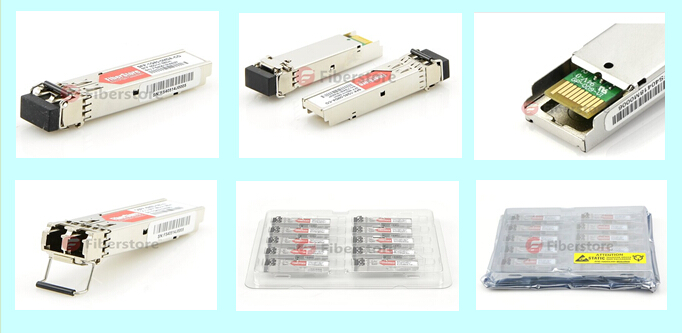
Key Features
- Data-rate of 1.25Gbps/1.063Gbps operation
- 850nm VCSEL laser and PIN photodetector for 550m transmission
- Hot-pluggable SFP footprint duplex LC connector Interface
- Class 1 FDA and IEC60825-1 Laser Safety Compliant
- Compatible with SFP MSA
- Compatible with SFF-8472
- +3.3V single power supply and TTL Logic Interface
- Average Output Power:-9.5~ -3dBm
- Receiver Sensitivity:-17dBm
- Extended temperature range (EXT):-5 to 85°C
- Built-in Digital Diagnostic Function
Applications
- Fiber Channel Links
- Gigabit Ethernet Links
- Fast Ethernet Links
- Other Optical Links
Where to Buy
Cisco SFP transceivers offered by Fiberstore are the most cost-effective standards-based SFP modules fully compatible with Cisco Switches & Routers. Fiberstore provides a series of Cisco comaptible SFP modules which can be equivalent to Cisco GLC SX 1000BASE SX SFP (GLC-SX-MM), Cisco SFP 1000BASE LX LH SM fiber transceiver (GLC-LH-SM), Cisco GLC-SX-MMD, Cisco GLC-LH-SMD, Cisco GLC-T 1000BASE-T SFP (GLC-T), Cisco GLC-ZX-SMD, and Cisco CWDM SFP, Cisco DWDM SFP, etc.
Read More Related Article About SFP Modules:
- Netgear AGM731F Compatible SFP for Gigabit EthernetApplications
- Cisco SFP Module GLC-SX-MM and GLC-SX-MMD
Oznake: GLC-SX-MMD, GLC-SX-MM, Cisco SFP
| < | srpanj, 2015 | |||||
| P | U | S | Č | P | S | N |
| 1 | 2 | 3 | 4 | 5 | ||
| 6 | 7 | 8 | 9 | 10 | 11 | 12 |
| 13 | 14 | 15 | 16 | 17 | 18 | 19 |
| 20 | 21 | 22 | 23 | 24 | 25 | 26 |
| 27 | 28 | 29 | 30 | 31 | ||
Srpanj 2015 (1)
Lipanj 2015 (4)
Svibanj 2015 (3)
Travanj 2015 (13)
Ožujak 2015 (10)
Veljača 2015 (8)
Siječanj 2015 (9)
Prosinac 2014 (4)
Dnevnik.hr
Gol.hr
Zadovoljna.hr
Novaplus.hr
NovaTV.hr
DomaTV.hr
Mojamini.tv
About Me
Ima Blogger, Just Share Various Fiber Optic Telecom Network Topics, Information, News, Questions, Sources and Network Solutions.
